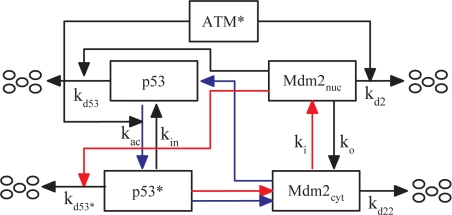Fig. 2.
Model of the p53–Mdm2 oscillator. Two forms of p53 in the nucleus are considered, inactive p53 and active p53*. Mdm2 in the nucleus and cytoplasm is denoted as Mdm2nuc and Mdm2cyt, respectively. They can shuttle between the two compartments at rates ki and ko. Inactive p53 is degraded rapidly by Mdm2 at a rate kd53, whereas active p53* is degraded slowly at a rate kd53* because of its weak binding affinity to Mdm2nuc. Combined negative (red lines) and positive (blue lines) feedback loops are responsible for p53 oscillations. In the negative-feedback loop, p53* promotes production of Mdm2cyt, which then enters the nucleus to induce degradation of p53*. In the positive-feedback loop, p53* induces Mdm2 to synthesize Mdm2cyt, which promotes the translation of p53 mRNA to produce inactive p53.

